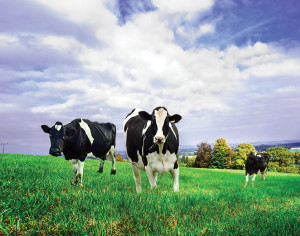 There are a lot more problems with the dairy industry than the price of milk.
There are a lot more problems with the dairy industry than the price of milk.
The Australian dairy farming industry is in a state of crisis. Cheap dairy products and fluctuations in both the domestic and global markets have taken a financial toll on farmers. Consumers have rallied to help struggling dairy producers.
But this is only half the problem. The true cost of dairy is also paid by dairy cows and the environment.
With the meat and dairy industries as the leading cause of global warming, in 2010, the UN announced that a global shift towards a plant-based diet is vital to save the world from hunger, fuel poverty and the worst impacts of climate change.
Despite the idyllic image of outdoor farming, several industry practices negatively affect dairy cows. To meet production demands, dairy cows are subject to a continuous cycle of impregnation, induced calving and milking. One of the most controversial issues is young “bobby” calves.
As well as systematic welfare problems, livestock farming is, both directly and indirectly, one of the most ecologically harmful human activities. The Australian livestock sector is worth A$17 billion and dairy cattle farming is a A$4.2 billion industry.
In Australia, livestock farming accounts for 10% to 16% of greenhouse gas emissions, with dairy farms contributing 19% of this, or 3% of total emissions. Methane emissions, from digestion and manure, and nitrous oxide from livestock are significant contributors. Globally, the livestock sector is responsible for more greenhouse gases than the world’s transport.
Livestock production accounts for 70% of all agricultural land, including the land used to grow crops to feed these animals. Animal agriculture is a key factor in land degradation, deforestation, water stress, pollution, and loss of biodiversity.
Livestock farming will also be affected by climate change, particularly changes in temperature and water. The quantity and quality of pasture and forage crops will also be affected. Diseases may increase due to fluctuating weather and climate.
Research shows that we must reduce food waste and losses in the supply chain and change our diets toward less resource-intensive diets, such as a plant-based diets. Doing so would cut emissions by two-thirds and save lives. It’s possible to eliminate animal suffering and reduce carbon emissions by reducing and replacing livestock production and consumption.
Alternatives to dairy milk include soy and almond milk. Soy milk is nutritionally comparable to dairy milk and has a significantly smaller environmental footprint.
Policy initiatives also need to address these issues. The Food and Agriculture Organisation’s Livestock’s Long Shadow report recommends a policy approach that correctly prices natural resources to reflect the full environmental costs and to end damaging subsidies. In the interim, higher taxes on meat and other livestock products will be necessary to improve public health and combat climate change.
Denmark, for instance, is considering proposals raise the tax on meat, after its ethics council concluded that “climate change is an ethical problem”.
Governments everywhere need to have a transitional plan for livestock producers and workers – one that helps to cultivate the ethical and sustainable agricultural endeavours of the future.
To read more at the Conversation CLICK HERE.




